Probing the Interaction between Isoflucypram Fungicides and Human Serum Albumin: Multiple Spectroscopic and Molecular Modeling Investigations
Abstract
1. Introduction
2. Results and Discussion
2.1. Molecular Docking Studies
2.2. Molecular Dynamics Simulation Results
2.3. Binding Mechanism
2.3.1. Fluorescence Quenching Spectra
2.3.2. Fluorescence Quenching Mechanism
2.3.3. Determination of Binding Constants and the Number of Binding Sites
2.3.4. Thermodynamic Parameters and Binding Forces Analysis
2.3.5. Energy Transfer and Binding Distance
2.4. Conformational Changes in HSA
2.4.1. UV-Visible Absorption Spectra and Analysis
2.4.2. Synchronous Fluorescence Spectra and Analysis
2.4.3. Three-Dimensional Fluorescence Spectra and Analysis
2.4.4. FT-IR Spectra and Analysis
2.4.5. CD Spectrum and Analysis
3. Materials and Methods
3.1. Reagents and Chemicals
3.2. Molecular Docking
3.3. Molecular Dynamics Simulation
3.4. Fluorescence Spectroscopy
3.5. UV-Vis Absorption Spectroscopy
3.6. Synchronous Fluorescence Spectroscopy
3.7. Three-Dimensional Fluorescence Spectroscopy
3.8. Fourier Transform Infrared Spectroscopy
3.9. CD Spectroscopy
4. Conclusions
Author Contributions
Funding
Institutional Review Board Statement
Informed Consent Statement
Data Availability Statement
Conflicts of Interest
References
- Storck, V.; Gallego, S.; Vasileiadis, S.; Hussain, S.; Beguet, J.; Rouard, N.; Baguelin, C.; Perruchon, C.; Devers-Lamrani, M.; Karpouzas, D.G. Insights into the Function and Horizontal Transfer of Isoproturon Degradation Genes (pdmAB) in a Biobed System. Appl. Environ. Microb. 2020, 86, e00474-20. [Google Scholar] [CrossRef]
- Ranz, R.E.R. Insecticides: Impact and Benefits of Its Use for Humanity, 3rd ed.; IntechOpen: London, UK, 2022; pp. 245–270. [Google Scholar]
- Da Costa, G.V.; Neto, M.F.A.; Da Silva, A.K.P.; De Sa, E.M.F.; Cancela, L.C.F.; Vega, J.S.; Lobato, C.M.; Zuliani, J.P.; Espejo-Roman, J.M.; Campos, J.M.; et al. Identification of Potential Insect Growth Inhibitor against Aedes aegypti: A Bioinformatics Approach. Int. J. Mol. Sci. 2022, 23, 8218. [Google Scholar] [CrossRef]
- Clark, R.D. Predicting mammalian metabolism and toxicity of pesticides in silico. Pest Manag. Sci. 2018, 74, 1992–2003. [Google Scholar] [CrossRef]
- Desbordes, P.; Essigmann, B.; Gary, S.; Gutbrod, O.; Maue, M.; Schwarz, H.G. Isoflucypram, the first representative of a new succinate dehydrogenase inhibitor fungicide subclass: Its chemical discovery and unusual binding mode. Pest Manag. Sci. 2020, 76, 3340–3347. [Google Scholar] [CrossRef]
- Yanicostas, C.; Soussi-Yanicostas, N. SDHI Fungicide Toxicity and Associated Adverse Outcome Pathways: What Can Zebrafish Tell Us? Int. J. Mol. Sci. 2021, 22, 12362. [Google Scholar] [CrossRef]
- Chen, X.; Li, W.H. Isoflucypram cardiovascular toxicity in zebrafish (Danio rerio). Sci. Total Environ. 2021, 787, 147529. [Google Scholar] [CrossRef]
- Xiao, P.; Liu, X.; Zhang, H.; Li, W.H. Chronic toxic effects of isoflucypram on reproduction and intestinal energy metabolism in zebrafish (Danio rerio). Environ. Pollut. 2022, 315, 120479. [Google Scholar] [CrossRef]
- Ascenzi, P.; Fanali, G.; Fasano, M.; Pallottini, V.; Trezza, V. Clinical relevance of drug binding to plasma proteins. J. Mol. Struct. 2014, 1077, 4–13. [Google Scholar] [CrossRef]
- Zhu, C.L.; Liu, F.R.; Wei, Y.L.; Zhang, F.; Pan, T.; Ye, Y.W.; Shen, Y.Z. Evaluating the potential risk by probing the site-selective binding of rutin-Pr(III) complex to human serum albumin. Food Chem. Toxicol. 2021, 148, 111927. [Google Scholar] [CrossRef]
- Szkudlarek, A.; Pentak, D.; Ploch, A.; Pozycka, J.; Maciazek-Jurczyk, M. In Vitro Investigation of the Interaction of Tolbutamide and Losartan with Human Serum Albumin in Hyperglycemia States. Molecules 2017, 22, 2249. [Google Scholar] [CrossRef]
- Curry, S. Lessons from the Crystallographic Analysis of Small Molecule Binding to Human Serum Albumin. Drug Metab. Pharmacokinet. 2009, 24, 342–357. [Google Scholar] [CrossRef]
- Sugio, S.; Kashima, A.; Mochizuki, S.; Noda, M.; Kobayashi, K. Crystal structure of human serum albumin at 2.5 angstrom resolution. Protein Eng. 1999, 12, 439–446. [Google Scholar] [CrossRef]
- Hu, Y.J.; Liu, Y.; Xiao, X.H. Investigation of the Interaction between Berberine and Human Serum Albumin. Biomacromolecules 2009, 10, 517–521. [Google Scholar] [CrossRef]
- Ploch-Jankowska, A.; Pentak, D.; Nycz, J.E. A Comprehensive Spectroscopic Analysis of the Ibuprofen Binding with Human Serum Albumin, Part II. Sci. Pharm. 2021, 89, 30. [Google Scholar] [CrossRef]
- Golianova, K.; Havadej, S.; Verebova, V.; Ulicny, J.; Holeckova, B.; Stanicova, J. Interaction of Conazole Pesticides Epoxiconazole and Prothioconazole with Human and Bovine Serum Albumin Studied Using Spectroscopic Methods and Molecular Modeling. Int. J. Mol. Sci. 2021, 22, 1925. [Google Scholar] [CrossRef]
- Zelonkova, K.; Havadej, S.; Verebova, V.; Holeckova, B.; Ulicny, J.; Stanicova, J. Fungicide Tebuconazole Influences the Structure of Human Serum Albumin Molecule. Molecules 2019, 24, 3190. [Google Scholar] [CrossRef]
- Sun, X.W.; Ferguson, H.N.; Hagerman, A.E. Conformation and Aggregation of Human Serum Albumin in the Presence of Green Tea Polyphenol (EGCg) and/or Palmitic Acid. Biomolecules 2019, 9, 705. [Google Scholar] [CrossRef]
- Jelicic, M.L.; Brusac, E.; Klaric, D.A.; Nigovic, B.; Turk, N.; Mornar, A. A chromatographic approach to development of 5-aminosalicylate/folic acid fixed-dose combinations for treatment of Crohn’s disease and ulcerative colitis. Sci. Rep. 2020, 10, 20838. [Google Scholar] [CrossRef]
- Pan, X.R.; Qin, P.F.; Liu, R.T.; Wang, J. Characterizing the Interaction between Tartrazine and Two Serum Albumins by a Hybrid Spectroscopic Approach. J. Agric. Food Chem. 2011, 59, 6650–6656. [Google Scholar] [CrossRef]
- Lakowicz, J.R.; Masters, B.R. Principles of Fluorescence Spectroscopy, 3rd ed.; Springer: Boston, MA, USA, 2006; pp. 278–281. [Google Scholar]
- Smolkova, R.; Zelenak, V.; Smolko, L.; Kuchar, J.; Rabajdova, M.; Ferencakova, M.; Marekova, M. Novel zinc complexes of a non-steroidal anti-inflammatory drug, niflumic acid: Structural characterization, human-DNA and albumin binding properties. Eur. J. Med. Chem. 2018, 153, 131–139. [Google Scholar] [CrossRef]
- Xu, L.; Hu, Y.X.; Li, Y.C.; Liu, Y.F.; Zhang, L.; Ai, H.X.; Liu, H.S. Study on the interaction of paeoniflorin with human serum albumin (HSA) by spectroscopic and molecular docking techniques. Chem. Cent. J. 2017, 11, 116. [Google Scholar] [CrossRef]
- Tang, Q.; Peng, X.J.; Cao, H.Y.; Yang, Y.J.; Ma, J.; Wang, J.Y.; Zheng, X.F. Site-Directed Mutagenesis of Myoglobin for Studies of Their Interaction with Iron(III) by Multi-Spectroscopic Techniques. J. Spectrosc. 2013, 2013, 314345. [Google Scholar] [CrossRef]
- Xu, L.; Hu, Y.X.; Li, Y.C.; Zhang, L.; Ai, H.X.; Liu, H.S.; Liu, Y.F.; Sang, Y.L. Study on the interaction of tussilagone with human serum albumin (HSA) by spectroscopic and molecular docking techniques. J. Mol. Struct. 2017, 1149, 645–654. [Google Scholar] [CrossRef]
- Zhou, W.N.; Peng, C.Y.; Wang, D.S.; Li, J.L.; Tu, Z.C.; Zhang, L. Interaction Mechanism between OVA and Flavonoids with Different Hydroxyl Groups on B-Ring and Effect on Antioxidant Activity. Foods 2022, 11, 1302. [Google Scholar] [CrossRef]
- Shahabadi, N.; Khorshidi, A.; Moghadam, N.H. Study on the interaction of the epilepsy drug, zonisamide with human serum albumin (HSA) by spectroscopic and molecular docking techniques. Spectrochim. Acta A 2013, 114, 627–632. [Google Scholar] [CrossRef]
- Zhu, M.Q.; Wang, L.J.; Wang, Y.; Zhou, J.; Ding, J.; Li, W.; Xin, Y.; Fan, S.S.; Wang, Z.; Wang, Y. Biointeractions of Herbicide Atrazine with Human Serum Albumin: UV-Vis, Fluorescence and Circular Dichroism Approaches. Int. J. Environ. Res. Public Health. 2018, 15, 116. [Google Scholar] [CrossRef]
- Lin, H.; Lan, J.F.; Guan, M.; Sheng, F.L.; Zhang, H.X. Spectroscopic investigation of interaction between mangiferin and bovine serum albumin. Spectrochim. Acta A 2009, 73, 936–941. [Google Scholar] [CrossRef]
- Lemli, B.; Derdak, D.; Laczay, P.; Kovacs, D.; Kunsagi-Mate, S. Noncovalent Interaction of Tilmicosin with Bovine Serum Albumin. Molecules 2018, 23, 1915. [Google Scholar] [CrossRef]
- Wang, K.; Wang, Z.; Xie, Y.H.; Xue, X.G.; Tang, S.F.; Hou, X.M. Molecular mechanism investigation on the interaction of Clothianidin with human serum albumin. Spectrosc. Lett. 2019, 52, 246–252. [Google Scholar] [CrossRef]
- Xu, H.L.; Yao, N.N.; Xu, H.R.; Wang, T.S.; Li, G.Y.; Li, Z.Q. Characterization of the Interaction between Eupatorin and Bovine Serum Albumin by Spectroscopic and Molecular Modeling Methods. Int. J. Mol. Sci. 2013, 14, 14185–14203. [Google Scholar] [CrossRef]
- Hashempour, S.; Shahabadi, N.; Adewoye, A.; Murphy, B.; Rouse, C.; Salvatore, B.A.; Stratton, C.; Mahdavian, E. Binding Studies of AICAR and Human Serum Albumin by Spectroscopic, Theoretical, and Computational Methodologies. Molecules 2020, 25, 5410. [Google Scholar] [CrossRef]
- Miller, J.N. Capillary separation methods: A key to high efficiency and improved detection capabilities. Analyst 1984, 109, 191–198. [Google Scholar] [CrossRef]
- Xiong, X.N.; He, J.W.; Yang, H.Q.; Tang, P.X.; Tang, B.; Sun, Q.M.; Li, H. Investigation on the interaction of antibacterial drug moxifloxacin hydrochloride with human serum albumin using multi-spectroscopic approaches, molecular docking and dynamical simulation. RSC Adv. 2017, 7, 48942–48951. [Google Scholar] [CrossRef]
- Barth, A.; Zscherp, C. What vibrations tell us about proteins. Q. Rev. Biophys. 2002, 35, 369–430. [Google Scholar] [CrossRef]
- Barth, A. Infrared spectroscopy of proteins. Biochim. Biophys. Acta BBA Bioenerg. 2007, 1767, 1073–1101. [Google Scholar] [CrossRef]
- Wang, Q.; Sun, Q.M.; Ma, X.L.; Rao, Z.S.; Li, H. Probing the binding interaction of human serum albumin with three bioactive constituents of Eriobotrta japonica leaves: Spectroscopic and molecular modeling approaches. J. Photochem. Photobiol. B 2015, 148, 268–276. [Google Scholar] [CrossRef]
- Szczukowski, L.; Krzyzak, E.; Zborowska, A.; Zajac, P.; Potyrak, K.; Peregrym, K.; Wiatrak, B.; Marciniak, A.; Swiatek, P. Design, Synthesis and Comprehensive Investigations of Pyrrolo[3,4-d]pyridazinone-Based 1,3,4-Oxadiazole as New Class of Selective COX-2 Inhibitors. Int. J. Mol. Sci. 2020, 21, 9623. [Google Scholar] [CrossRef]
- Shahabadi, N.; Hadidi, S.; Feizi, F. Study on the interaction of antiviral drug ‘Tenofovif’ with human serum albumin by spectral and molecular modeling methods. Spectrochim. Acta A 2015, 138, 169–175. [Google Scholar] [CrossRef]
- Xu, J.H.; Wang, M.Y.; Zheng, Y.Z.; Tang, L. Spectroscopic Technique-Based Comparative Investigation on the Interaction of Theaflavins with Native and Glycated Human Serum Albumin. Molecules 2019, 24, 3171. [Google Scholar] [CrossRef]
- Li, Z.Q.; Zhao, L.D.; Sun, Q.M.; Gan, N.; Zhang, Q.Y.; Yang, J.; Yi, B.; Liao, X.X.; Zhu, D.L.; Li, H. Study on the interaction between 2,6-dihydroxybenzoic acid nicotine salt and human serum albumin by multi-spectroscopy and molecular dynamics simulation. Spectrochim. Acta A 2022, 270, 120868. [Google Scholar] [CrossRef]
- Wu, J.; Bi, S.Y.; Sun, X.Y.; Zhao, R.; Wang, J.H.; Zhou, H.F. Study on the interaction of fisetholz with BSA/HSA by multi-spectroscopic, cyclic voltammetric, and molecular docking technique. J. Biomol. Struct. Dyn. 2019, 37, 3496–3505. [Google Scholar] [CrossRef]
- Fischer, E. Einfluss der Configuration auf die Wirkung der Enzyme. Berichte Dtsch. Chem. Ges. 2006, 27, 2985–2993. [Google Scholar] [CrossRef]
- O’Boyle, N.M.; Banck, M.; James, C.A.; Morley, C.; Vandermeersch, T.; Hutchison, G.R. Open Babel: An open chemical toolbox. J. Cheminform. 2011, 3, 33. [Google Scholar] [CrossRef]
- Eberhardt, J.; Santos-Martins, D.; Tillack, A.F.; Forli, S. AutoDock Vina 1.2.0: New Docking Methods, Expanded Force Field, and Python Bindings. J. Chem. Inf. Model. 2021, 61, 3891–3898. [Google Scholar] [CrossRef]
- Trott, O.; Olson, A.J. Software News and Update AutoDock Vina: Improving the Speed and Accuracy of Docking with a New Scoring Function, Efficient Optimization, and Multithreading. J. Comput. Chem. 2010, 31, 455–461. [Google Scholar]
- Lashkov, A.A.; Tolmachev, I.V.; Eistrikh-Heller, P.A.; Rubinsky, S.V. PyFepRestr: Plugin to PyMOL Molecular Graphics System for Calculating the Free Energy of Ligand-Receptor Binding. Crystallogr. Rep. 2021, 66, 861–865. [Google Scholar] [CrossRef]
- Bowers, K.J.; Chow, D.E.; Xu, H.; Dror, R.O.; Eastwood, M.P.; Gregersen, B.A.; Klepeis, J.L.; Kolossvary, I.; Moraes, M.A.; Sacerdoti, F.D.; et al. In Scalable Algorithms for Molecular Dynamics Simulations on Commodity Clusters. In Proceedings of the 2006 ACM/IEEE Conference on Supercomputing, New York, NY, USA, 11–17 November 2006. [Google Scholar]
- Gu, Q.; Kenny, J.E. Improvement of Inner Filter Effect Correction Based on Determination of Effective Geometric Parameters Using a Conventional Fluorimeter. Anal. Chem. 2009, 81, 420–426. [Google Scholar] [CrossRef]
- Wang, W.J.; Gan, N.; Sun, Q.M.; Wu, D.; Gan, R.X.; Zhang, M.; Tang, P.X.; Li, H. Study on the interaction of ertugliflozin with human serum albumin in vitro by multispectroscopic methods, molecular docking, and molecular dynamics simulation. Spectrochim. Acta A 2019, 219, 83–90. [Google Scholar] [CrossRef]
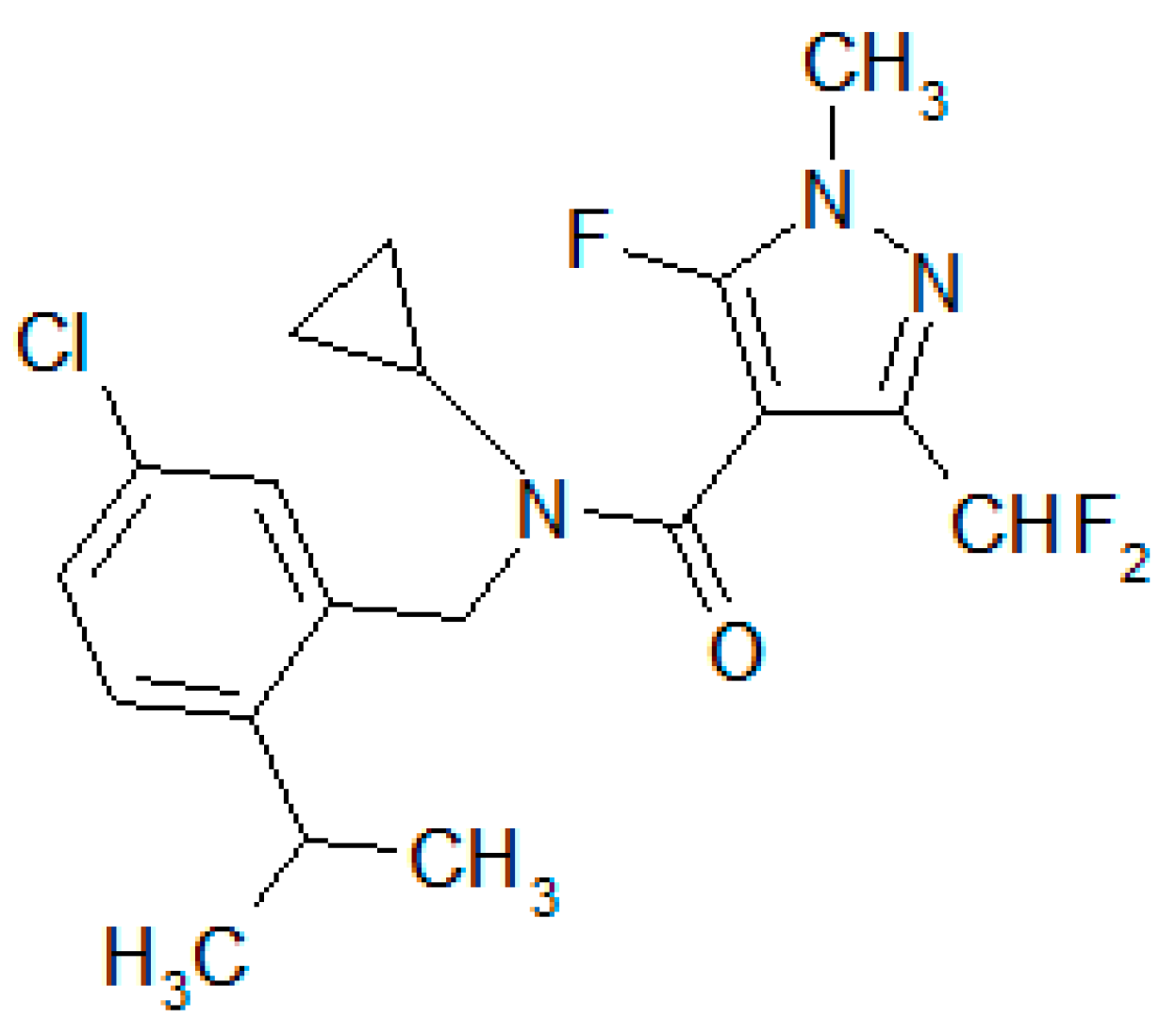
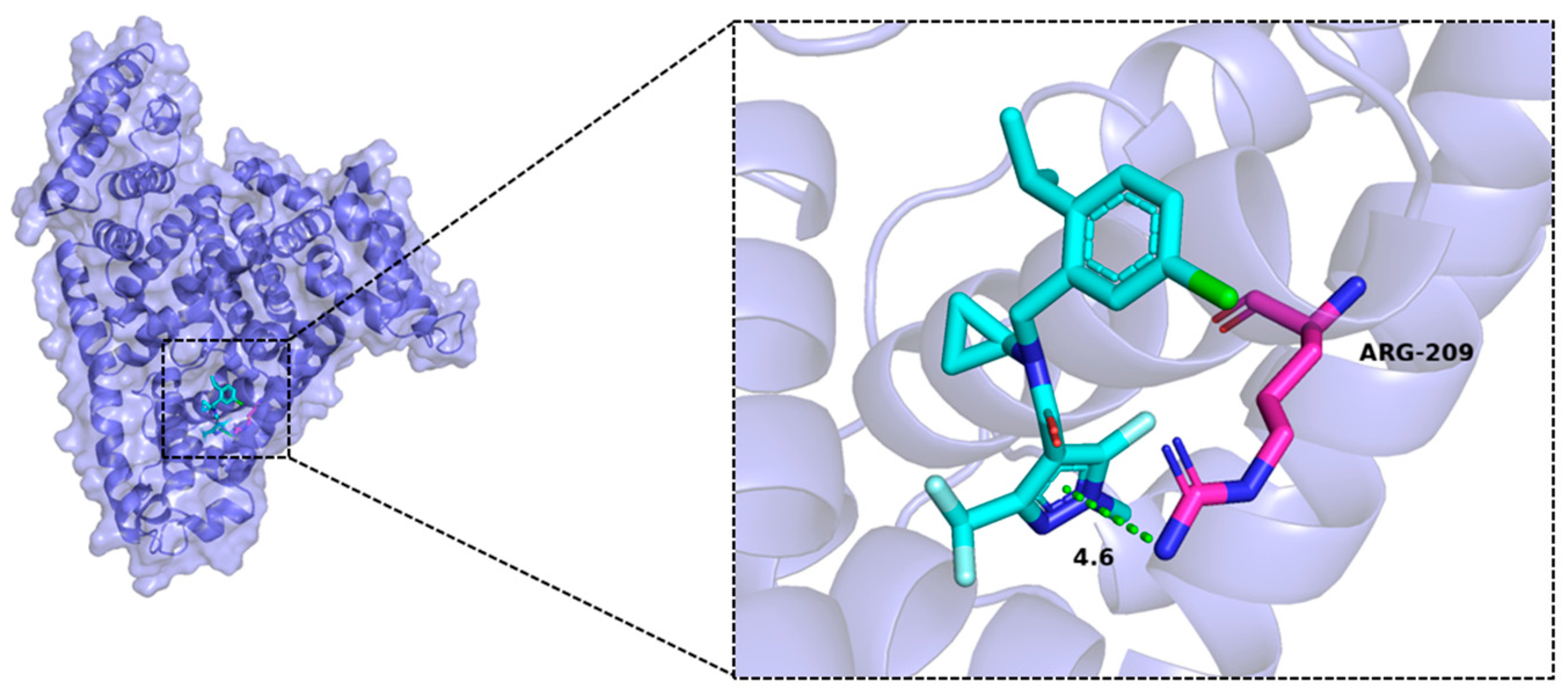
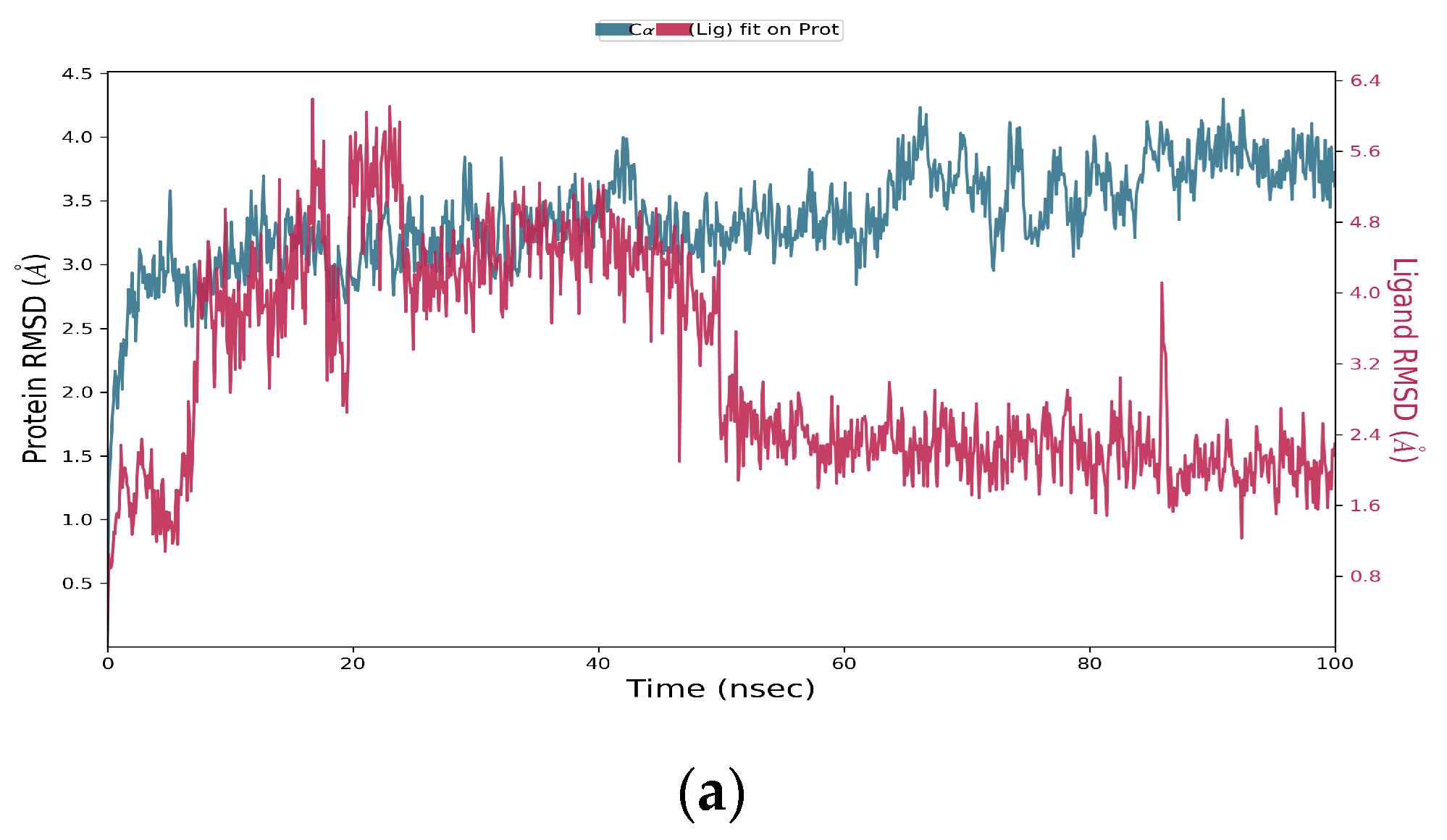

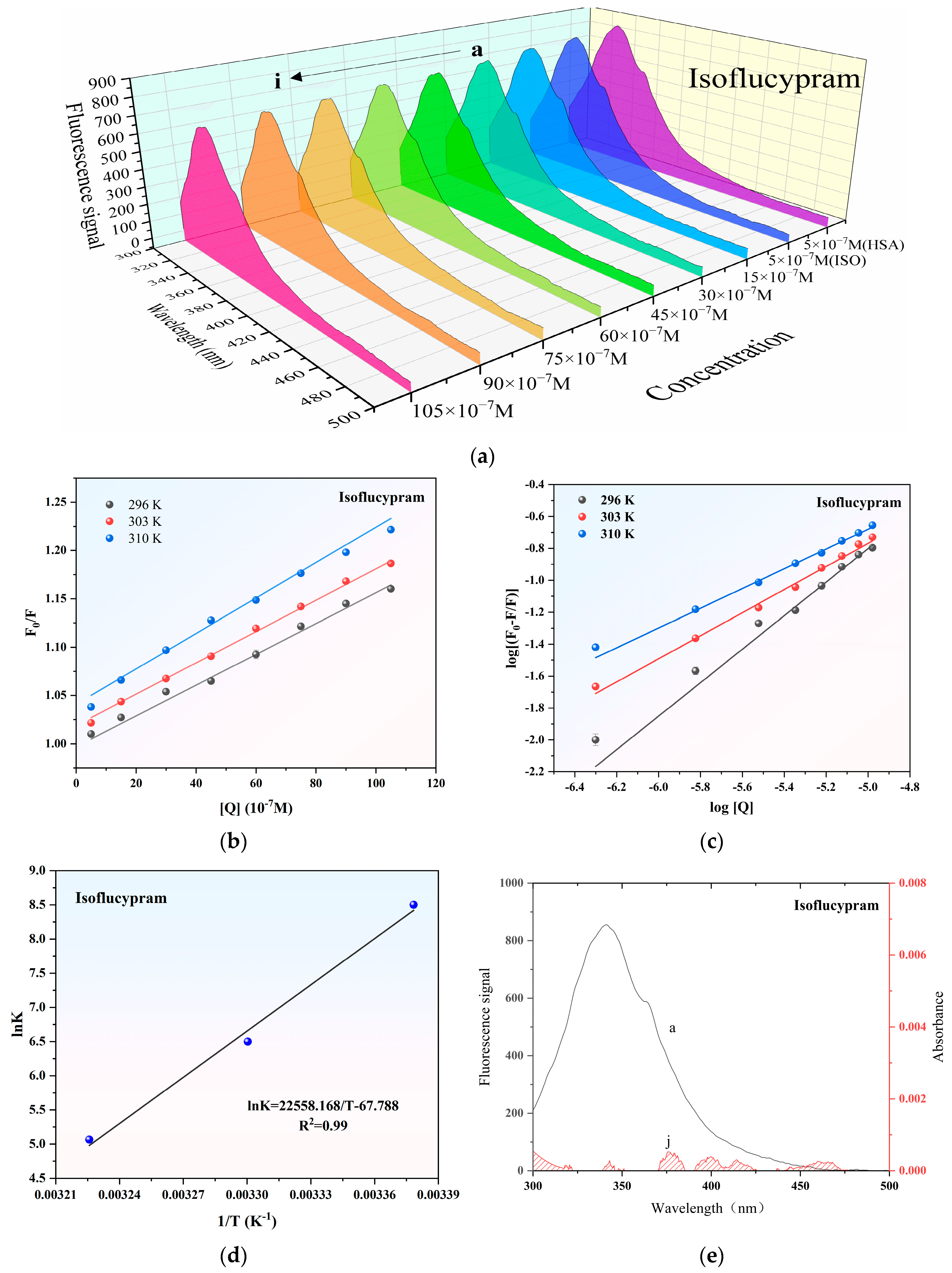
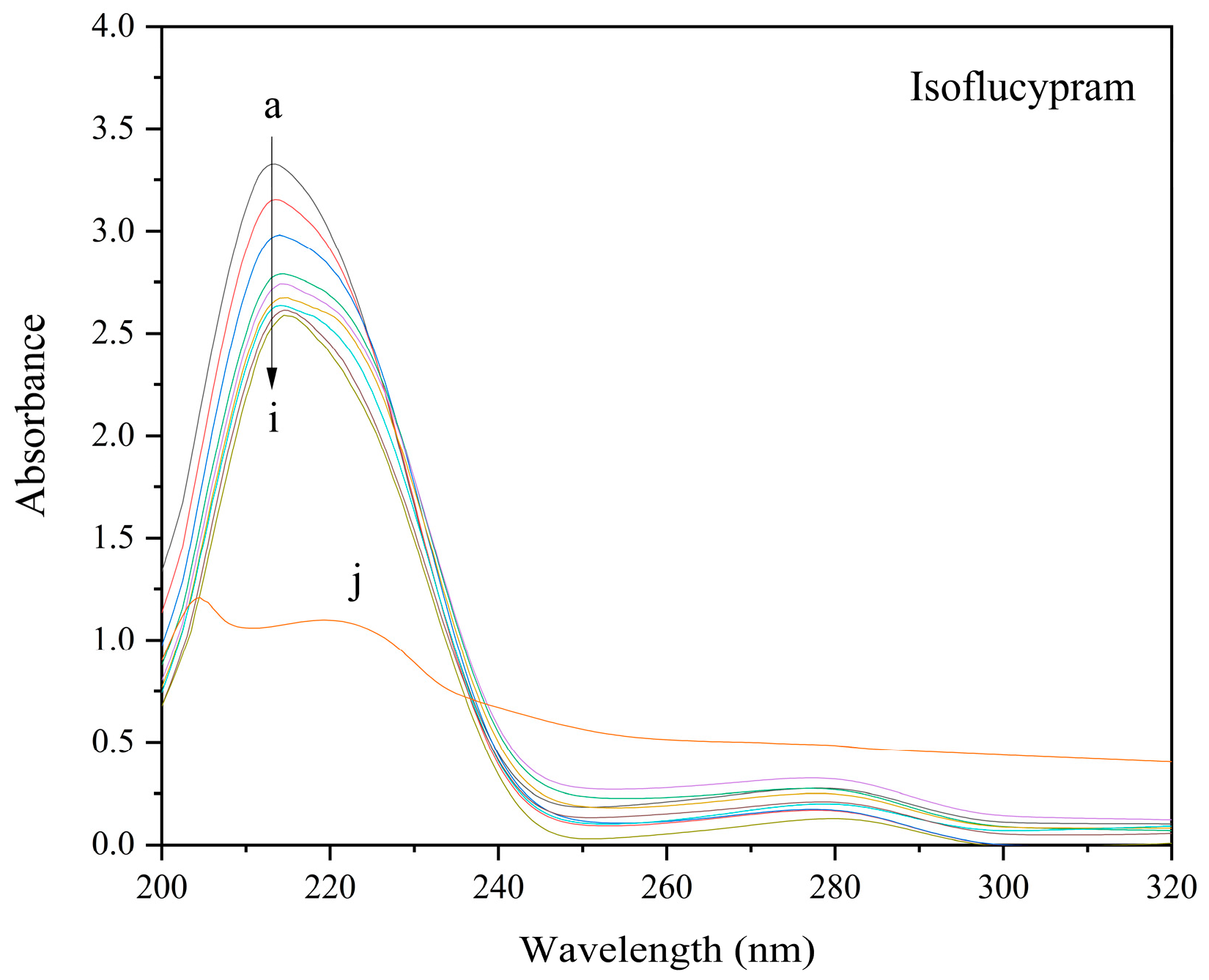
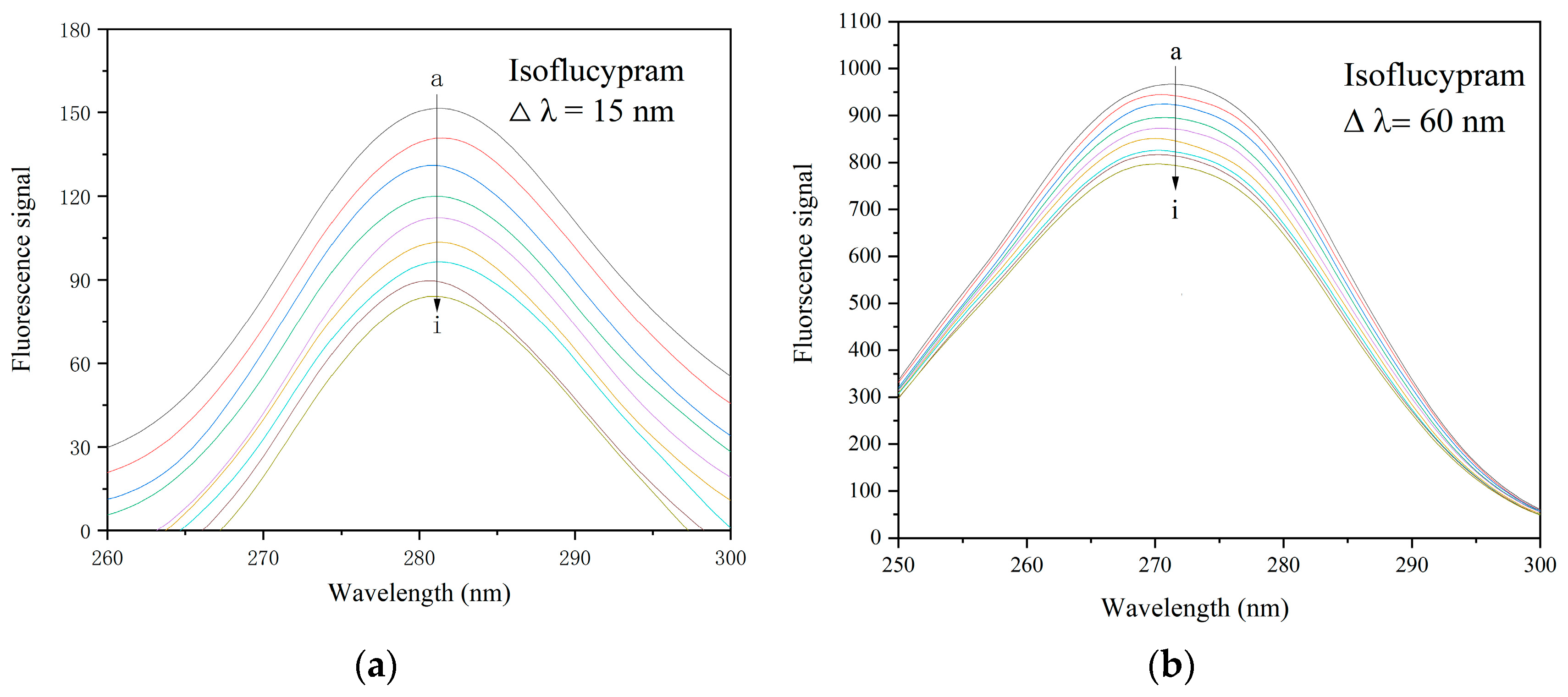
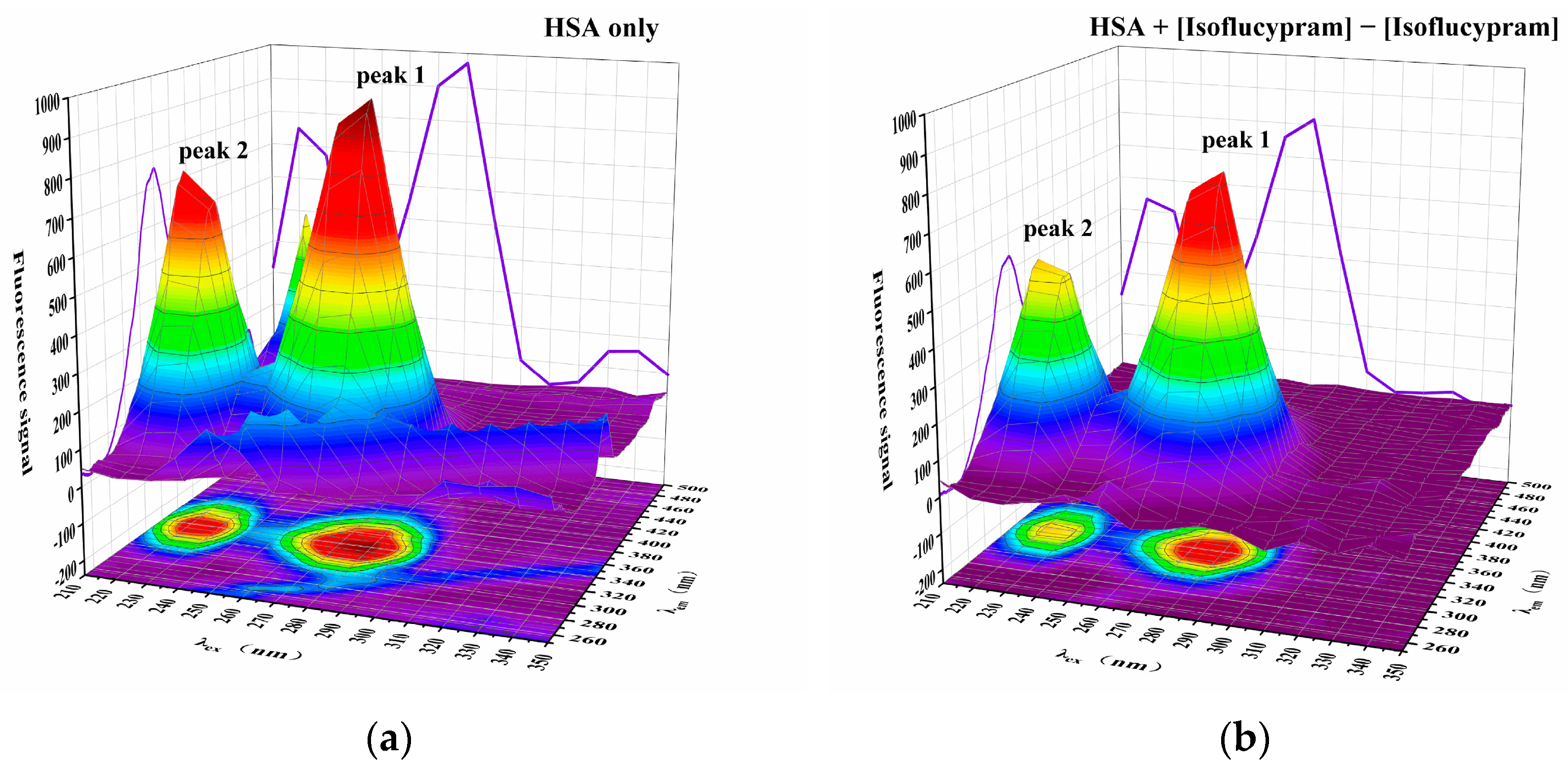
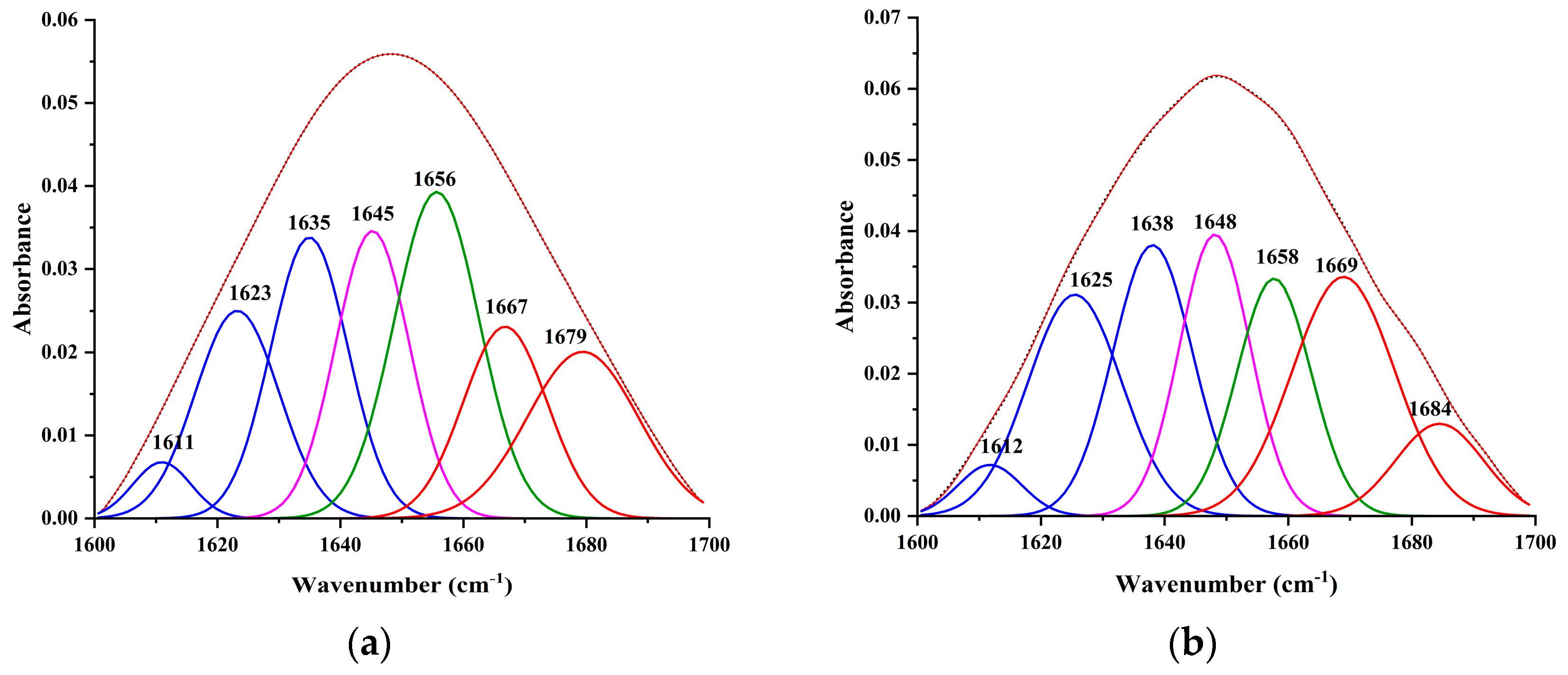
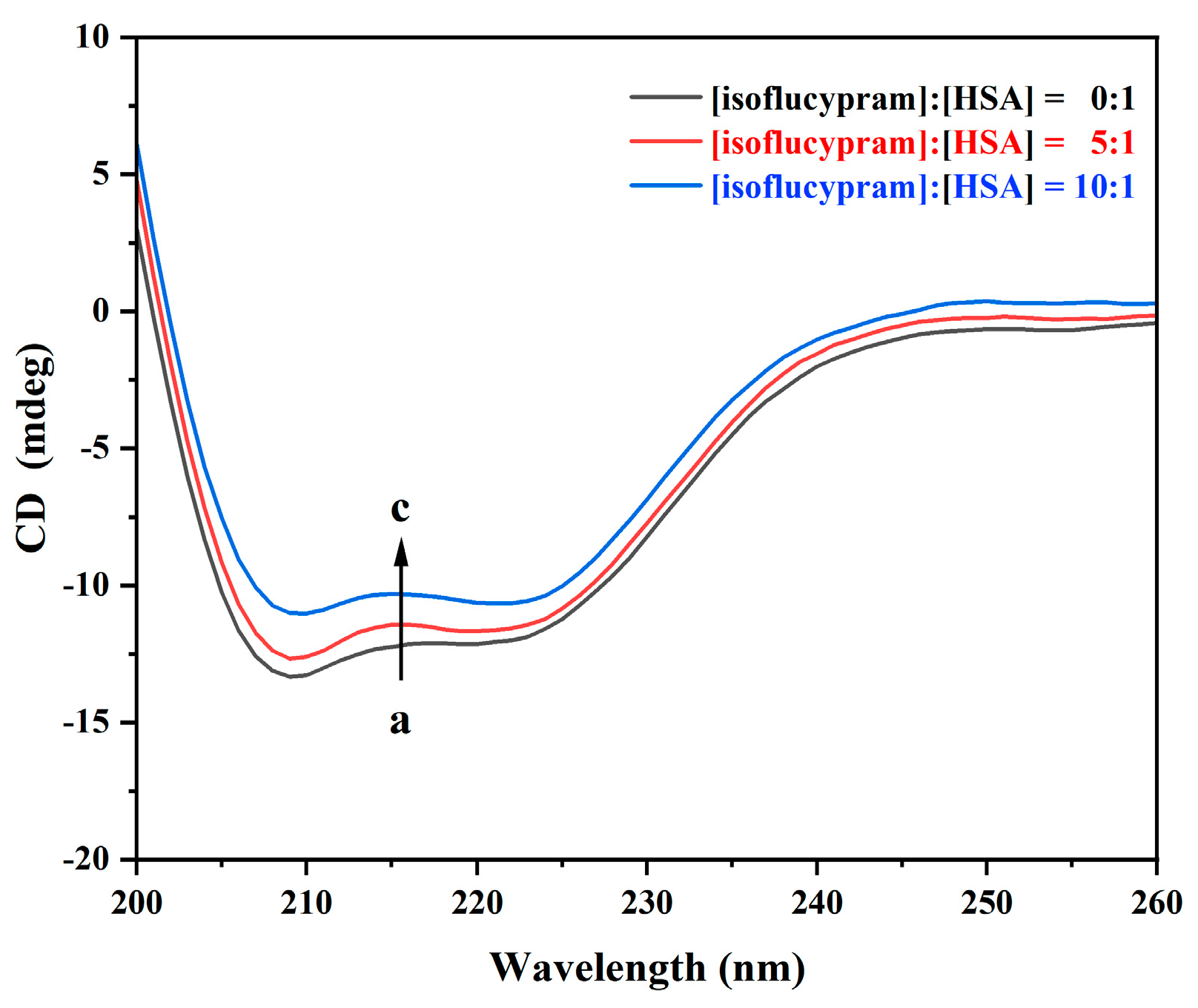
| T (K) | Ksv (104 M−1) | R2 | Kq (1012 M−1·s−1) | n | Ka (103 M−1) |
|---|---|---|---|---|---|
| 296 K | 1.593 ± 0.073 | 0.994 | 1.593 ± 0.073 | 0.901 ± 0.011 | 4.923 ± 0.619 |
| 303 K | 1.619 ± 0.027 | 0.999 | 1.619 ± 0.027 | 0.803 ± 0.006 | 0.664 ± 0.037 |
| 310 K | 1.832 ± 0.076 | 0.995 | 1.832 ± 0.076 | 0.577 ± 0.006 | 0.158 ± 0.011 |
| T (K) | ΔH0 (KJ·mol−1) | ΔS0 (J·mol−1·K−1) | ΔG0 (KJ·mol−1) | J (cm3·L·mol−1) | R0 (nm) | E | r (nm) |
|---|---|---|---|---|---|---|---|
| 310 K | −187.549 | −563.59 | −12.836 | 1.183 × 10−17 | 1.170 | 3.67% | 2.017 |
| Secondary Structures (%) | Only HSA | Isoflucypram + HSA |
|---|---|---|
| α-helix | 22.04% | 15.22% |
| β-sheet | 33.63% | 39.35% |
| β-turn | 27.49% | 28.24% |
| random coil | 16.84% | 17.19% |
Disclaimer/Publisher’s Note: The statements, opinions and data contained in all publications are solely those of the individual author(s) and contributor(s) and not of MDPI and/or the editor(s). MDPI and/or the editor(s) disclaim responsibility for any injury to people or property resulting from any ideas, methods, instructions or products referred to in the content. |
© 2023 by the authors. Licensee MDPI, Basel, Switzerland. This article is an open access article distributed under the terms and conditions of the Creative Commons Attribution (CC BY) license (https://creativecommons.org/licenses/by/4.0/).
Share and Cite
Li, X.; Yan, X.; Yang, D.; Chen, S.; Yuan, H. Probing the Interaction between Isoflucypram Fungicides and Human Serum Albumin: Multiple Spectroscopic and Molecular Modeling Investigations. Int. J. Mol. Sci. 2023, 24, 12521. https://doi.org/10.3390/ijms241512521
Li X, Yan X, Yang D, Chen S, Yuan H. Probing the Interaction between Isoflucypram Fungicides and Human Serum Albumin: Multiple Spectroscopic and Molecular Modeling Investigations. International Journal of Molecular Sciences. 2023; 24(15):12521. https://doi.org/10.3390/ijms241512521
Chicago/Turabian StyleLi, Xiangshuai, Xiaojing Yan, Daibin Yang, Shuning Chen, and Huizhu Yuan. 2023. "Probing the Interaction between Isoflucypram Fungicides and Human Serum Albumin: Multiple Spectroscopic and Molecular Modeling Investigations" International Journal of Molecular Sciences 24, no. 15: 12521. https://doi.org/10.3390/ijms241512521
APA StyleLi, X., Yan, X., Yang, D., Chen, S., & Yuan, H. (2023). Probing the Interaction between Isoflucypram Fungicides and Human Serum Albumin: Multiple Spectroscopic and Molecular Modeling Investigations. International Journal of Molecular Sciences, 24(15), 12521. https://doi.org/10.3390/ijms241512521







